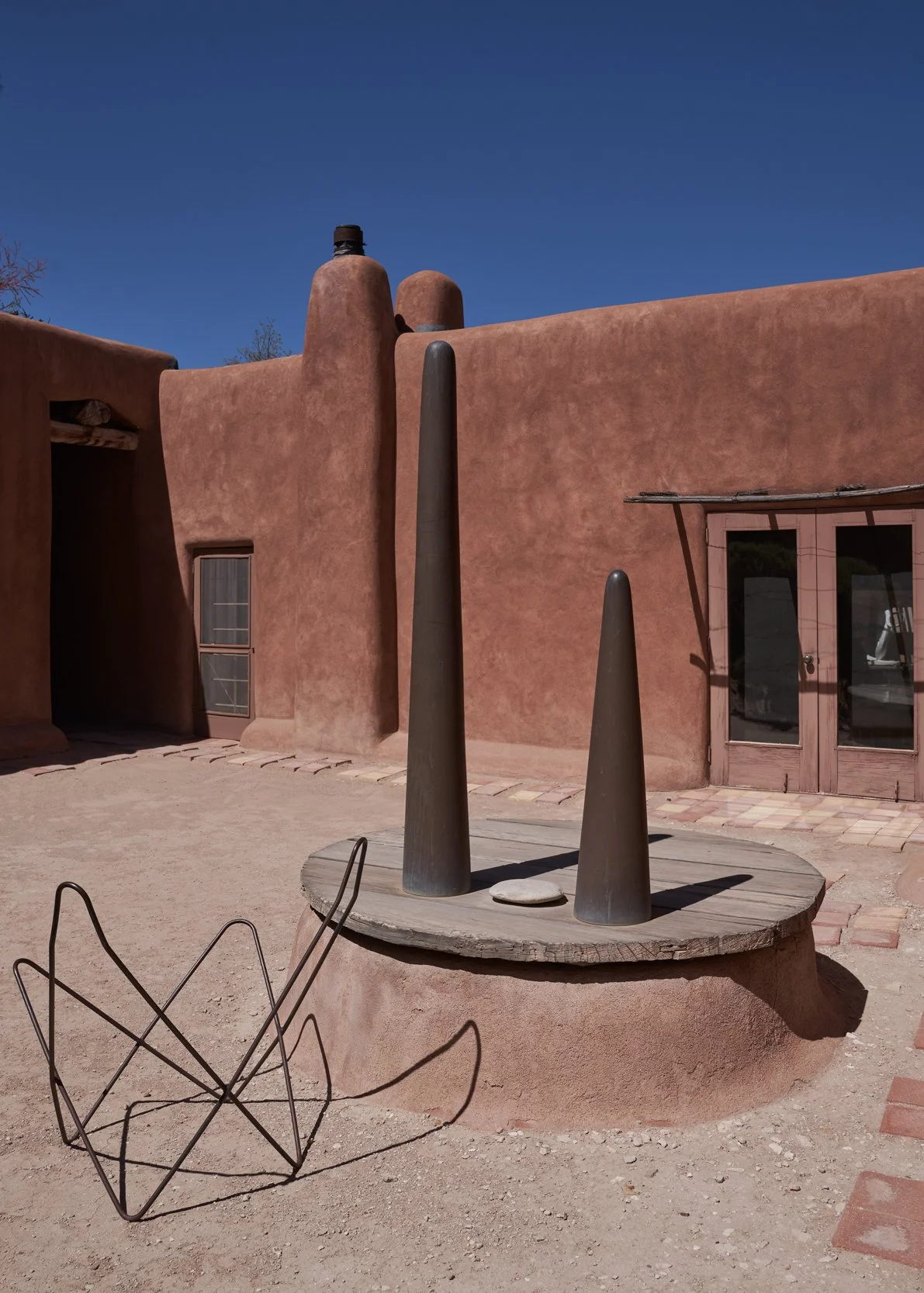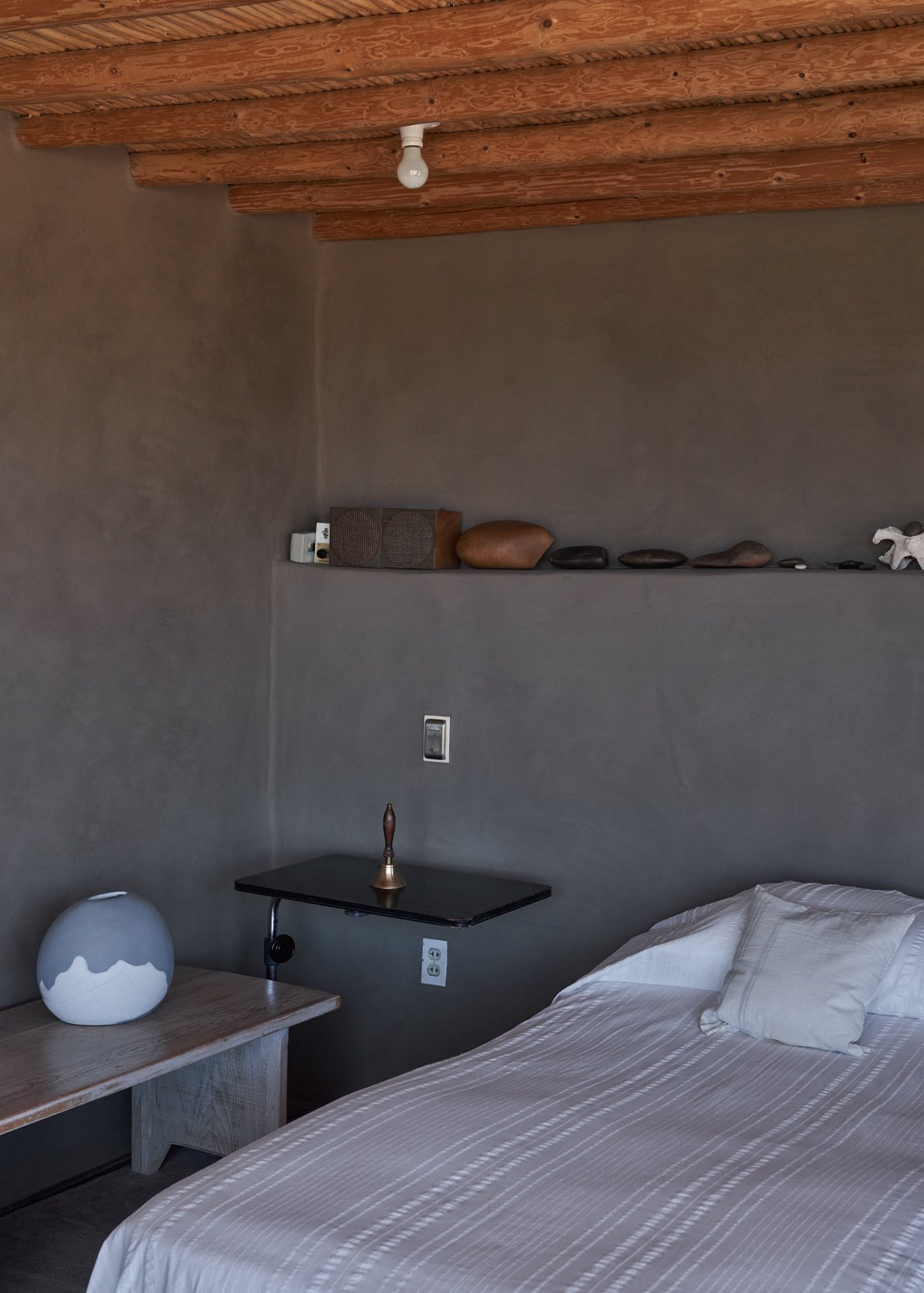Words Anna Godbersen Photography Martien Mulder
Published in No 18
Georgia O’Keeffe in Abiquiú Studio, 1965. Photo: Balthazar Korab. Gift of The Georgia O’Keeffe Foundation. © Georgia O’Keeffe Museum.
“Where I was born and where and how I have lived is unimportant,” Georgia O’Keeffe wrote in a 1976 monograph that paired drawings and paintings from throughout her long career with striking anecdotes of the places that inspired her work. “It is what I have done with where I have been that should be of interest.”
“What I have done” might well include not only the paintings and drawings, but also O’Keeffe’s iconic personal style. Living Modern, a 2017 Brooklyn Museum exhibition, took this approach, celebrating aspects of O’Keeffe’s everyday life, her abilities as a seamstress, the way she kept house. The exhibition’s catalog argues for the inclusion of her sartorial and design choices as part of a total work of art, citing O’Keeffe’s friend Frances O’Brien: “Georgia O’Keeffe never allowed her life to be one thing and her painting another.”
The main entrance in the distance. The Abiquiú studio was made from the ruins of an outbuilding that had once housed animals.
Perhaps none of O’Keeffe’s homes were as integral to her life and work as the Plazuela style house she bought in the town of Abiquiú, situated along the Rio Chama, an hour north of Santa Fe, between two national forests. Giustina Renzoni, the Georgia O’Keeffe Museum’s Curator of Historic Properties, also views the artist’s domestic spaces, especially the one in Abiquiú, as an extension of her larger aesthetic vision — not only a form of self-expression, but also crucial to her ongoing process. “She had this opportunity to almost design the house from the ground up,” Renzoni says. “She was able to strike out on her own and really settle into this sense of place. To not only appreciate the landscape, but to build up this environment around her that fostered her creativity and supported her independence.”
The places where O’Keeffe spent time are apparent in her oeuvre — West Texas, Lake George, Manhattan. But no place captured her eye, or is as intrinsic to her legacy, as northern New Mexico, where she made her home for the second half of her long life. When she visited the region in 1929, she wrote to her sister Catherine: “I am West again and it is as fine as I remembered it… for me it is the only place.”
O’Keeffe removed walls from three rooms. making a sitting room that opens into the dining room.
That summer of 1929, O’Keeffe’s destination was Taos and the artist’s colony ruled by another notable Anglo resident of the region, the memoirist and wealthy arts patron Mabel Dodge Luhan. The area was already a draw for bohemians and creatives, especially for women experimenting with their sexual and gender identities. (Hence the old-time euphemism “Gone Santa Fe” for coming out as a lesbian.) O’Keeffe must have felt the pull of that American romance with the West, striking out in the name of self-invention. When she was a child, her mother read her stories of Kit Carson and Billy the Kid; “It had always seemed to me that the West must be wonderful—there was no place I knew of that I would rather go.”
By 1929 her artistic practice was established; the decisions she made about her daily life had to be in service of her work. The west was not just a romantic idea; it had a practical appeal, too, offering inspiration and new vistas, a high desert air quality that allowed one to see a great distance. Later in life, O’Keeffe would remark of the light in New Mexico that, as a painter, “half your work is done for you.”
The kitchen.
That summer was not O’Keeffe’s first time in the state, but it began to shift O’Keeffe’s orientation, from the New York art world and her husband Alfred Stieglitz to New Mexico and herself. She was in her early forties and already a successful painter. The Brooklyn Museum had given her a retrospective, and her work was slated to be shown at the Museum of Modern Art that winter. But she was weighted with the considerations of an artist at midcareer. Having experienced success, she must have felt the pressure to continue not only producing, but innovating. She wrote to her friend, the writer Sherwood Anderson: “keeping the unknown always beyond you—catching—crystalizing your simpler clearer vision of life—only to see it turn stale compared to what you vaguely feel ahead—that you must always keep working to grasp—" Yet this idealized, searching process had to be balanced with more prosaic demands. Money worries, the obtuseness of critics, the imperative to feed the press, and a marriage to a man more than twenty years her senior. Alfred Stieglitz was by then in his sixties; he and O’Keeffe had been living together for a decade. He was her husband, mentor, and dealer. Early in her career, he had championed her work in his role as a gallerist and tastemaker and influenced her public image with his efforts as a photographer, extensively documenting her nude body, her face, her hands.
Renzoni points out that the nudes Stieglitz created of O’Keeffe were widely seen, and that this may have left her sensitive to being labeled a muse as much as artist in her own right. Those images may also have contributed to the narrow interpretations of O’Keeffe’s paintings — made by contemporary art critics, and which she herself resisted — as symbolic of female anatomy. “Stieglitz encouraged her,” Renzoni says. “Empowered her. But she really valued her solitude, and she was not able to experience that very much when she was in New York with Stieglitz. It was not an easy relationship. There was turbulence. For her, coming out to New Mexico, it’s this opportunity to reconnect with herself. Alfred Stieglitz never came to New Mexico.”
After 1929, during the years Stieglitz was still alive, O’Keeffe would leave New York in the summers and return to New Mexico, at first staying at Mabel Dodge Luhan’s compound in Taos, then renting and eventually buying a cottage, known as Rancho de los Burros, and several acres of the Rancho de los Brujos on which it sat, anglicized and now known as Ghost Ranch. In 1945, not long before Stieglitz’ death, she purchased a second home, a hacienda in deep disrepair last used by the Catholic Church to store farm animals, about sixteen miles from the ranch.
One of the fire places.
A ladder on the patio.
Ghost Ranch offered a spectacular setting, but it was difficult to access and, with no heat or running water, made for rough living. The roads were bad, vulnerable to flash floods. The environs were rife with rattlesnakes. O’Keeffe, who had grown up on a farm and was health-conscious, wanted a garden. She found that it was impossible to grow fruits or vegetables on the poor soil at Ghost Ranch. Abiquiú had a scant population but did have such amenities as a general store and a butcher and, crucially, the property came with water rights. The pueblo was founded and is still populated by the descendants of genízaro families — Indigenous peoples who had been enslaved by the Spanish, then were given a land grant in exchange for creating a buffer town, a defensive outpost against threats from the north. The town was served by the acequias, a communal irrigation system that combined indigenous and Spanish practices to direct spring water to crops.
“When I first saw the Abiquiú house it was a ruin,” O’Keeffe wrote in the 1976 monograph, Georgia O’Keeffe. “I found a patio with a very pretty well house and bucket to draw up water. It was a good-sized patio with a long wall with a door on one side. That wall with a door in it was something I had to have. It took me ten years to get it—three more years to fix the house so I could live in it—and after that the wall with a door was painted many times.”
The artist’s bedroom.
The renovation was done without an architect, marrying O’Keeffe’s singular modernist aesthetic with the region’s vernacular architecture. The project was overseen by a Texan named Maria Chabot, a rancher and aspiring writer who possessed many of the practical skills necessary for survival in remote country. Renzoni estimates that something like 22,000 adobe bricks were used in the construction, which was done according to the traditional building practices of the region. The final mudding treatment, done by hand, was a women’s job. O’Keeffe was proud of this — saying that her house was made by the hands of women — although she also incorporated principles of contemporary design and modernist architecture, bringing a sense of the outside indoors, for instance.
“Two walls of my room in the Abiquiú house are glass and from one window I see the road to Espanola, Santa Fe and the world,” O’Keeffe wrote. “The road fascinates me with its ups and downs and finally its wide sweep as it speeds toward the wall of my hilltop to go past me.”
Although the house was more accessible than the one at Ghost Ranch, it was still remote enough to protect O’Keeffe from her growing celebrity. She entertained, but her life in New Mexico was oriented to her studio and to the landscape, with which she was in constant conversation. She often went on long camping trips in the rugged country that surrounded her homes, to the badlands site she called “The Black Place” and others, to paint. The property sustained O’Keeffe’s domestic practices as well. She grew apple, apricot, mulberry, fig and peach trees, tomatoes, corn and green chilies, chamomile, and mint, and canned, dried and pickled the produce of her garden. And she continued her prolific output, painting not only the wall with the door, but also local churches and crosses and the cliffs and hills near Abiquiú.
In one of Stieglitz’s last letters to O’Keeffe — mailed from New York so that it would arrive before she landed in New Mexico for the summer of 1946 — he wrote, “I greet you on your coming once more to your own country.” A month later, she received the news that he had suffered a massive stroke and returned to New York to be with him when he died. She scattered his ashes near his family compound at Lake George. By fall she was back in Abiquiú. The next forty years of O’Keeffe’s life were organized to be close to the scenes that she painted over and over. After she died, her own ashes were scattered on the mesa top of nearby Cerro Pedernal.
In Georgia O’Keeffe, she paired a 1936 rendering of the Red Hills in front of the distinct flat top of Pedernal with the following text: “The unexplainable thing in nature that makes me feel the world is big far beyond my understanding—to understand maybe by trying to put it into form. To find the feeling of infinity on the horizon line or just over the next hill.”
okeeffemuseum.org
This feature has been made possible by the support of the Tavolozza Foundation. tavolozzafoundation.com
Anna Godbersen is a regular contributor to UD. She the author of The Blonde among other novels. annagodbersen.co
Martien Mulder is a regular contributor to UD. @martienmulder wschupfer.com









